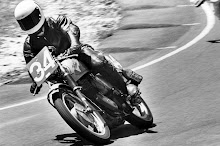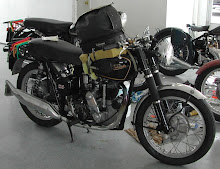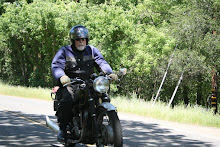Following an earlier posting on my blog of the 1948 Earles court Motorcycle show Velocette stand, John Jennings , with whom as editor of FTDU I am collaborating in the publishing of the diaries of the Adelaide dealer and South Australian Velocette importer Lou Borgelt, reminded me of a section of interest from one of Lou's 1948 diaries. I've included it below, as  it refers to his ride on the then new LE150 from the Velocette works and comments between himself and Eugene Goodman, then a director of Veloce Ltd and whose vision for Veloce Ltd lay with the "everyman machine", in their case the LE.
it refers to his ride on the then new LE150 from the Velocette works and comments between himself and Eugene Goodman, then a director of Veloce Ltd and whose vision for Veloce Ltd lay with the "everyman machine", in their case the LE.
 it refers to his ride on the then new LE150 from the Velocette works and comments between himself and Eugene Goodman, then a director of Veloce Ltd and whose vision for Veloce Ltd lay with the "everyman machine", in their case the LE.
it refers to his ride on the then new LE150 from the Velocette works and comments between himself and Eugene Goodman, then a director of Veloce Ltd and whose vision for Veloce Ltd lay with the "everyman machine", in their case the LE. I would go so far as to say he was "blinkered" in his outlook for the companies motorcycle models, intending to cease production of all but the LE.
It would be another 30 years before the Honda 50 would sweep all before it starting Honda on it's road to economic fame and fortune.
It too was an "everyman machine".
Two photos are included, for whom acknowledgement is made to Keystone Press Agency Ltd., London, UK , one of which I've posted before.

From the Borgelt Diaries.....
Borgelt Diary Extract – Wed 17th November 1948, Birmingham UK
I return to the Grand Hotel where Mrs. Borgelt hands me a letter from the J.A.P. works, also one from Australia House with lengthy leaflet about the Aboriginal picture exhibition in London. I break my glasses so take them to optician for new frame.
Have lunch at the Midland Hotel and do we go short? Oh no! Thick soup, bread, guinea fowl, potatoes and cauliflower, apple-date pie. It cost 5/- but it was a dinner. Nobody eating at restaurants or Hotels go short, they have plenty of food; it is the housewife who suffers. This morning at breakfast had sort of Weetbix and pears, large plate of fish with a tomato and few mushrooms. Toast, enough butter. Sugar in shakers for cereal and plenty of sugar loaf for tea (A big fellah breakfast). Room, bed and breakfast cost two of us 42/- per day (wow!).
Mr. Percy Williams stayed here recently (of Sydney) anyhow may as well swank it even if we can’t afford it. The room faces a small park and the Birmingham Cathedral in the centre, a large window, room 25’ x 13’, two single beds, hot and cold water, easy chair and two chairs, writing table, dressing and make up table for Mrs. Borgelt, telephone, eiderdowns and a large wardrobe and wall to wall carpet. Nuff said and we are comfortable and that is what matters.
Take bus to Veloce works. Meet Mr. Percy and a Swede in his office. I wander around the works and look up Tommy Mutton who gets an L.E. ready for me to ride on the road. He loans me his zipper flying suit and gloves and away I go. Pick up 1 gallon petrol. Here they have a double ticket, with 1/2 gallon on each. I say one gallon and tank would not take it; I hand out ticket and chaps look at me in horror to say ‘what are you putting over’, because it was only a 1/2 gallon ticket. I apologise and they siphon 1/2 gallon from tank and I pay 1/1d. Several chaps come along to look at the L.E. Velo while one, a policeman in plain clothes, asks how can he get to Australia. I give him my card and tell him to write to the Commissioner of Police, Adelaide, and I continue my trial run on the L.E. and find it is very excellent to ride. It has a feeling of stability, really silent and smooth -to ride. I return to works, crawl out of suit and am back for tea at the works. Meet Mr. Eugene Goodman, a brother of Mr. Percy, and the designer of the L.E. Velo. We have a general discussion re a 200 L.E. and the desirability to continue with the M.A.C. Eugene took it in I am sure, but he says why should they continue with an old 1933 model, an out of date bike. I differed to say it is still the most excellent of its type!
I return to the Grand Hotel where Mrs. Borgelt hands me a letter from the J.A.P. works, also one from Australia House with lengthy leaflet about the Aboriginal picture exhibition in London. I break my glasses so take them to optician for new frame.
Have lunch at the Midland Hotel and do we go short? Oh no! Thick soup, bread, guinea fowl, potatoes and cauliflower, apple-date pie. It cost 5/- but it was a dinner. Nobody eating at restaurants or Hotels go short, they have plenty of food; it is the housewife who suffers. This morning at breakfast had sort of Weetbix and pears, large plate of fish with a tomato and few mushrooms. Toast, enough butter. Sugar in shakers for cereal and plenty of sugar loaf for tea (A big fellah breakfast). Room, bed and breakfast cost two of us 42/- per day (wow!).
Mr. Percy Williams stayed here recently (of Sydney) anyhow may as well swank it even if we can’t afford it. The room faces a small park and the Birmingham Cathedral in the centre, a large window, room 25’ x 13’, two single beds, hot and cold water, easy chair and two chairs, writing table, dressing and make up table for Mrs. Borgelt, telephone, eiderdowns and a large wardrobe and wall to wall carpet. Nuff said and we are comfortable and that is what matters.
Take bus to Veloce works. Meet Mr. Percy and a Swede in his office. I wander around the works and look up Tommy Mutton who gets an L.E. ready for me to ride on the road. He loans me his zipper flying suit and gloves and away I go. Pick up 1 gallon petrol. Here they have a double ticket, with 1/2 gallon on each. I say one gallon and tank would not take it; I hand out ticket and chaps look at me in horror to say ‘what are you putting over’, because it was only a 1/2 gallon ticket. I apologise and they siphon 1/2 gallon from tank and I pay 1/1d. Several chaps come along to look at the L.E. Velo while one, a policeman in plain clothes, asks how can he get to Australia. I give him my card and tell him to write to the Commissioner of Police, Adelaide, and I continue my trial run on the L.E. and find it is very excellent to ride. It has a feeling of stability, really silent and smooth -to ride. I return to works, crawl out of suit and am back for tea at the works. Meet Mr. Eugene Goodman, a brother of Mr. Percy, and the designer of the L.E. Velo. We have a general discussion re a 200 L.E. and the desirability to continue with the M.A.C. Eugene took it in I am sure, but he says why should they continue with an old 1933 model, an out of date bike. I differed to say it is still the most excellent of its type!
Left click on photos to enlarge.
































































